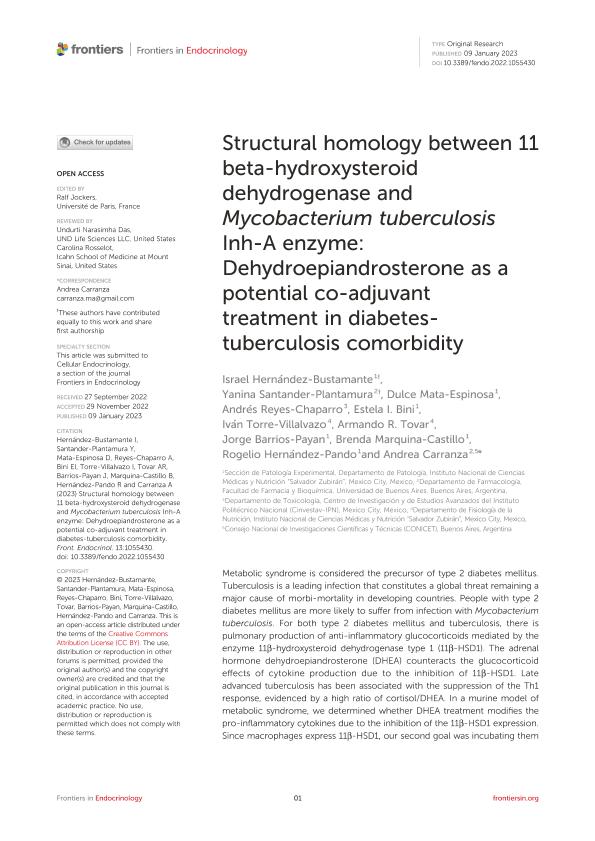Artículo
Structural homology between 11 beta-hydroxysteroid dehydrogenase and Mycobacterium tuberculosis Inh-A enzyme: Dehydroepiandrosterone as a potential co-adjuvant treatment in diabetes-tuberculosis comorbidity
Hernández Bustamante, Israel; Santander Plantamura, Yanina Alejandra; Mata Espinosa, Dulce; Reyes Chaparro, Andrés; Bini, Estela Isabel; Torre Villalvazo, Iván; Tovar, Armando R.; Barrios Payan, Jorge; Marquina Castillo, Brenda; Hernández Pando, Rogelio; Carranza, Maria Andrea

Fecha de publicación:
01/2023
Editorial:
Frontiers Media
Revista:
Frontiers in Endocrinology
e-ISSN:
1664-2392
Idioma:
Inglés
Tipo de recurso:
Artículo publicado
Clasificación temática:
Resumen
Metabolic syndrome is considered the precursor of type 2 diabetes mellitus. Tuberculosis is a leading infection that constitutes a global threat remaining a major cause of morbi-mortality in developing countries. People with type 2 diabetes mellitus are more likely to suffer from infection with Mycobacterium tuberculosis. For both type 2 diabetes mellitus and tuberculosis, there is pulmonary production of anti-inflammatory glucocorticoids mediated by the enzyme 11β-hydroxysteroid dehydrogenase type 1 (11β-HSD1). The adrenal hormone dehydroepiandrosterone (DHEA) counteracts the glucocorticoid effects of cytokine production due to the inhibition of 11β-HSD1. Late advanced tuberculosis has been associated with the suppression of the Th1 response, evidenced by a high ratio of cortisol/DHEA. In a murine model of metabolic syndrome, we determined whether DHEA treatment modifies the pro-inflammatory cytokines due to the inhibition of the 11β-HSD1 expression. Since macrophages express 11β-HSD1, our second goal was incubating them with DHEA and Mycobacterium tuberculosis to show that the microbicide effect was increased by DHEA. Enoyl-acyl carrier protein reductase (InhA) is an essential enzyme of Mycobacterium tuberculosis involved in the mycolic acid synthesis. Because 11β-HSD1 and InhA are members of a short-chain dehydrogenase/reductase family of enzymes, we hypothesize that DHEA could be an antagonist of InhA. Our results demonstrate that DHEA has a direct microbicide effect against Mycobacterium tuberculosis; this effect was supported by in silico docking analysis and the molecular dynamic simulation studies between DHEA and InhA. Thus, DHEA increases the production of pro-inflammatory cytokines in the lung, inactivates GC by 11β-HSD1, and inhibits mycobacterial InhA. The multiple functions of DHEA suggest that this hormone or its synthetic analogs could be an efficient co-adjuvant for tuberculosis treatment.
Archivos asociados
Licencia
Identificadores
Colecciones
Articulos(OCA HOUSSAY)
Articulos de OFICINA DE COORDINACION ADMINISTRATIVA HOUSSAY
Articulos de OFICINA DE COORDINACION ADMINISTRATIVA HOUSSAY
Citación
Hernández Bustamante, Israel; Santander Plantamura, Yanina Alejandra; Mata Espinosa, Dulce; Reyes Chaparro, Andrés; Bini, Estela Isabel; et al.; Structural homology between 11 beta-hydroxysteroid dehydrogenase and Mycobacterium tuberculosis Inh-A enzyme: Dehydroepiandrosterone as a potential co-adjuvant treatment in diabetes-tuberculosis comorbidity; Frontiers Media; Frontiers in Endocrinology; 13; 1055430; 1-2023; 1-16
Compartir
Altmétricas



